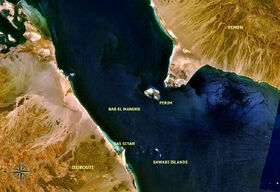
Bab-el-Mandeb area with description
The Bab-el-Mandeb (variously transliterated Mandab or Mandib, and with article "el-" given also as "al-", with or without connecting dashes) meaning "Gate of Tears" in Arabic (باب المندب), is a strait located between Yemen on the Arabian Peninsula and Djibouti and Eritrea, north of Somalia in the Horn of Africa, and connecting the Red Sea to the Gulf of Aden. It is sometimes called the Mandab Strait in English.
Overview[]

Bathymetric map of the Red Sea with the Bab-el-Mandeb at the bottom right
The strait derives its name from the dangers attending its navigation, or, according to an Arab legend, from the numbers who were drowned by the earthquake which separated Asia and Africa. In an Arabic translation of Jules Verne's book Around the World in Eighty Days, it is referred to as the "Bridge of Tears".
The distance to the shore of the Cape Dezhnev in Russia is 10,855 km, which is the largest dimension of mainland Asia.
Bab el-Mandab acts as a strategic link between the Indian Ocean and the Mediterranean Sea, via the Red Sea and the Suez Canal. In 2006, an estimated 3.3 million barrels (520,000 m3) of oil passed through the strait per day, out of a world total of about 43 million barrels per day (6,800,000 m3/d) moved by tankers.[1]
The distance across is about 20 miles (30 km) from Ras Menheli in Yemen to Ras Siyan in Djibouti. The island of Perim divides the strait into two channels, of which the eastern, known as the Bab Iskender (Alexander's Strait), is 2 miles (3 km) wide and 16 fathoms (30 m) deep, while the western, or Dact-el-Mayun, has a width of about 16 miles (25 km) and a depth of 170 fathoms (310 m). Near the coast of Djibouti lies a group of smaller islands known as the "Seven Brothers." There is a surface current inwards in the eastern channel, but a strong undercurrent outwards in the western channel.
According to the recent single origin hypothesis, the straits of Bab-el-Mandeb were probably witness to the earliest migrations of modern humans out of Africa, which occurred roughly 60,000 years ago.[2][3] At this time, the oceans were much lower and the straits were much shallower or dry, allowing a series of emigrations along the southern coast of Asia.
According to Ethiopian Orthodox Tewahedo Church tradition, the straits of Bab-el-Mendeb were witness to the earliest migrations of Semitic Ge'ez speakers into Africa, occurring roughly around the same time as the Hebrew patriarch Jacob[4].
Suspension Bridge[]
On February 22, 2008, it was revealed that a company owned by Tarek bin Laden is planning to build a bridge named Bridge of the Horns across the strait, linking Yemen with Djibouti[5]
Middle East Development LLC has issued a notice to construct a bridge passing across the Red Sea that would be the longest suspended passing in the world.[6]
References[]
- ↑ World Oil Transit Chokepoints, Energy Information Administration, US Department of Energy
- ↑ Spencer Wells, The Journey of Man
- ↑ Stephen Oppenheimer. The Gates of Grief
- ↑ Official website of EOTC
- ↑ BBC NEWS | Africa | Tarek Bin Laden's Red Sea bridge
- ↑ http://enr.construction.com/news/intl/archives/070501.asp
External links[]
| Wikisource has the text of the 1911 Encyclopædia Britannica article Bab-el-Mandeb. |
- Some or all of this article is forked from Wikipedia. The original article was at Bab-el-Mandeb. The list of authors can be seen in the page history.
- Notice-to-Proceed Launches Ambitious Red Sea Crossing
- Sea crossing